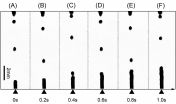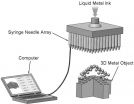(Press-News.org) Three-dimensional metal printing technology is an expanding field that has enormous potential applications in areas ranging from supporting structures, functional electronics to medical devices. Conventional 3D metal printing is generally restricted to metals with a high melting point, and the process is rather time consuming.
Now scientists at the Beijing Key Laboratory of CryoBiomedical Engineering, part of the Technical Institute of Physics and Chemistry at the Chinese Academy of Sciences, have developed a new conceptual 3D printing method with "ink" consisting of a metal alloy that has a melting point slightly above room temperature.
In a new study published by the journal SCIENCE CHINA Technological Sciences, researchers Liu Jing and Wang Lei present a liquid-phase 3D printing technique for the rapid manufacturing of a conductive metal object in one, two or three dimensions. Compared with air cooling in conventional 3D printing, their liquid-phase manufacturing process prevents the metal ink from oxidation.
They outline their findings in a study entitled "Liquid phase 3D printing for quickly manufacturing conductive metal objects with a low melting point alloy ink."
In recent years, these scientists state, metals with a low melting point, especially metals that melt at room temperature, have attracted extensive attention in the areas of computer chip cooling, thermal interface materials, and microfluidics. "Such material has also been proposed as printing ink with evident value in direct writing electronics and 3D printing technology," the Beijing researchers add. In their new study, a four-element alloy, Bi35In48.6Sn16Zn0.4, was developed and adopted as the printing ink.
These scientists likewise developed a streamlined fabrication process.
First, a 3D object is generated as a computer-aided design (CAD) model, and then converted into an STL (STereoLithography) file. The STL file is imported into an open source software program that generates slices of the object as a set of horizontal layers and that generates tool paths for each layer. The printing ink is dropped into a liquid phase cooling fluid via an injection needle; the object is printed layer by layer.
During the process of liquid phase 3D printing, several factors affect the final printing quality.
The types and properties of the printing ink dominate the fabrication process. In principle, any metal with a low melting point (or less than 300°C) can be selected as a printing ink on condition that an appropriate cooling liquid is available. The ink material can be an alloy based on gallium, bismuth, or indium, or even a mixture of these alloys and nanoparticles.
Compared to conventional metal prototyping techniques, liquid phase 3D printing offers several distinct advantages: (1) At a relatively high speed of manufacturing, the process of printing metal objects in a liquid phase can be used to form three-dimensional structures. The temperature field and flow field of the cooling fluid can be flexibly controlled. Through regulating the flow velocity and direction of the cooling fluid, some unique 3D metal structures can be realized, e.g. a 3D rotating body. (2) 3D electromechanical systems can be printed. A conductive liquid metal can be used in conjunction with nonmetal materials (e.g. plastic) to form 3D functional devices that include supporting structures and conductive devices. The combination of liquid phase 3D printing and conventional printing can meet all kinds of objectives.
In the new study, researchers at the Beijing Key Laboratory of CryoBiomedical Engineering also describe the contours of a liquid phase 3D printer of the future. To optimize the accuracy and speed of 3D printing, they propose adopting a combination of a syringe pump array and a syringe needle array. In this system, the syringe pump array is used to extract the liquid metal solution, while the syringe needle array is deployed to inject the liquid metal ink into the cooling fluid. The injection needles can be replaced conveniently with others of different sizes to meet various printing objectives. Transforming digital 3D models into printed structures and controlling each needle's injection speed are completed through a computer-implemented process. In this way, 3D metal objects are printed on the bottom of a trough holding the cooling fluid, formed of water, ethanol or other substance.
INFORMATION:
This work was partially supported by the Key Research Program of the Chinese Academy of Sciences (Grant No. KGZD-EW-T04).
See the article: Wang L, Liu J. Liquid phase 3D printing for quickly manufacturing conductive metal objects with a low melting point alloy ink. SCI CHINA TECHNOL SC, 2014 Vol. 57 (9): 1721-1728
http://tech.scichina.com:8082/sciEe/EN/abstract/abstract514724.shtml
http://link.springer.com/article/10.1007/s11431-014-5583-4
SCIENCE CHINA Technological Sciences is produced by Science China Press, which is a leading publisher of scientific journals in China that operates under the auspices of the Chinese Academy of Sciences. Science China Press presents to the world leading-edge advancements made by Chinese scientists across a spectrum of fields.
http://www.scichina.com/
Chinese scientists unveil liquid phase 3-D printing method using low melting metal alloy ink
2014-09-30
ELSE PRESS RELEASES FROM THIS DATE:
First dark matter search results from Chinese underground lab hosting PandaX-I experiment
2014-09-30
Scientists across China and the United States collaborating on the PandaX search for dark matter from an underground lab in southwestern China report results from the first stage of the experiment in a new study published in the Beijing-based journal SCIENCE CHINA Physics, Mechanics & Astronomy.
PandaX is the first dark matter experiment in China that deploys more than one hundred kilograms of xenon as a detector; the project is designed to monitor potential collisions between xenon nucleons and weakly interactive massive particles, hypothesized candidates for dark matter.
In ...
New estimates on carbon emissions triggered by 300 years of cropland expansion in Northeast China
2014-09-30
The conversion of forests, grasslands, shrublands and wetlands to cropland over the course of three centuries profoundly changed the surface of the Earth and the carbon cycle of the terrestrial ecosystem in Northeast China.
In a new study published in the Beijing-based journal SCIENCE CHINA Earth Sciences, a team of researchers from Beijing Normal University, Nanjing University of Information Science & Technology, and the Institute of Geographic Sciences and Natural Resources Research of the Chinese Academy of Sciences, present new calculations on carbon emissions triggered ...
Alcohol makes smiles more 'contagious,' but only for men
2014-09-30
Consuming an alcoholic beverage may make men more responsive to the smiles of others in their social group, according to new research in Clinical Psychological Science, a journal of the Association for Psychological Science. The findings suggest that, for men, alcohol increases sensitivity to rewarding social behaviors like smiling, and may shed light on risk factors that contribute to problem drinking among men.
"This experimental alcohol study, which included a social context, finds the clearest evidence yet of greater alcohol reinforcement for men than women," says ...
Slim cigarette smokers not exposed to more harmful chemicals
2014-09-30
A new study confirms that the exposure to tar tended to be lower for smokers of slim cigarettes than of regular cigarettes. Similarly, exposure to nicotine tended to be lower.
Slim cigarettes are an increasingly popular type of cigarette in several countries around the world. Previous studies have shown that the levels of certain toxic chemicals in the smoke of these cigarettes are lower than those in regular cigarettes. However, because lower levels of chemicals in the smoke are not necessarily linked to a reduced exposure to harmful chemicals, concerns had been raised ...
Genomic data could help doctors know whether to prescribe statins
2014-09-30
Genomic data could predict whether statins will benefit a patient or not, according to an article in the open access journal Genome Biology. The research suggests that genomic data alone can explain around 15% of patients' responses to a cholesterol-lowering statin, and further studies could increase the accuracy of these predictions.
The study looked at data from 372 participants in an American clinical trial for the statin, Simvastatin, and found that certain genetic signatures were more common in patients whose cholesterol was effectively lowered by the treatment, ...
Half of global wildlife lost, says new WWF report
2014-09-30
Washington, DC – Monday, September 29: Between 1970 and 2010 populations of mammals, birds, reptiles, amphibians, and fish around the globe dropped 52 percent, says the 2014 Living Planet Report released today by World Wildlife Fund (WWF). This biodiversity loss occurs disproportionately in low-income countries—and correlates with the increasing resource use of high-income countries.
In addition to the precipitous decline in wildlife populations the report's data point to other warning signs about the overall health of the planet. The amount of carbon in our atmosphere ...
Association of physical activity with diabetes is weakest among women at high genetic risk
2014-09-30
New research published in Diabetologia (the journal of the European Association for the Study of Diabetes) suggests that the protective effect of physical activity against diabetes is weakest among those at high genetic risk. The research is by Dr Yann Klimentidis, an Assistant Professor at the University of Arizona Mel and Enid Zuckerman College of Public Health, in Tucson, AZ, USA, and colleagues.
It is well established that physical activity reduces type 2 diabetes risk. However, the extent of protection afforded by physical activity may differ according to genetic ...
Annals of Internal Medicine tip sheet for Sept. 30, 2014
2014-09-30
Prop 46 Physician Drug Testing Mandate May Harm Patients it Aims to Protect
A new California ballot initiative being touted as a patient safety measure may create more problems than it solves, according to two new commentaries being published in Annals of Internal Medicine. Proposition 46, the Medical Malpractice Lawsuits Cap and Drug Testing of Doctors Initiative, would mandate random drug and alcohol testing of physicians and quadruple the cap on medical malpractice awards to $1.1 million. The authors argue that physician drug and alcohol testing should be unrelated ...
Landmark Medicare law had little impact on reducing chemotherapy cost
2014-09-30
WASHINGTON — Legislation passed in 2003 to slow the spiraling costs of drugs paid for by the federal government to treat Medicare patients has had no meaningful impact on cancer chemotherapy drug costs, say a team of researchers in the Journal of Clinical Oncology published online today.
"We looked at use of outpatient chemotherapy to treat colorectal and lung cancers, and did not find a substantial change in how oncologists prescribe those drugs following the implementation of the recent Medicare law in 2005," says the study's senior author, Arnold L. Potosky, PhD, a ...
Plants prepackage beneficial microbes in their seeds
2014-09-30
WASHINGTON, DC – September 29, 2014 -- Plants have a symbiotic relationship with certain bacteria. These 'commensal' bacteria help the pants extract nutrients and defend against invaders – an important step in preventing pathogens from contaminating fruits and vegetables. Now, scientist have discovered that plants may package their commensal bacteria inside of seeds; thus ensuring that sprouting plants are colonized from the beginning. The researchers, from the University of Notre Dame, presented their findings today at the 5th ASM Conference on Beneficial Microbes.
Plants ...





